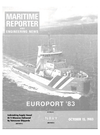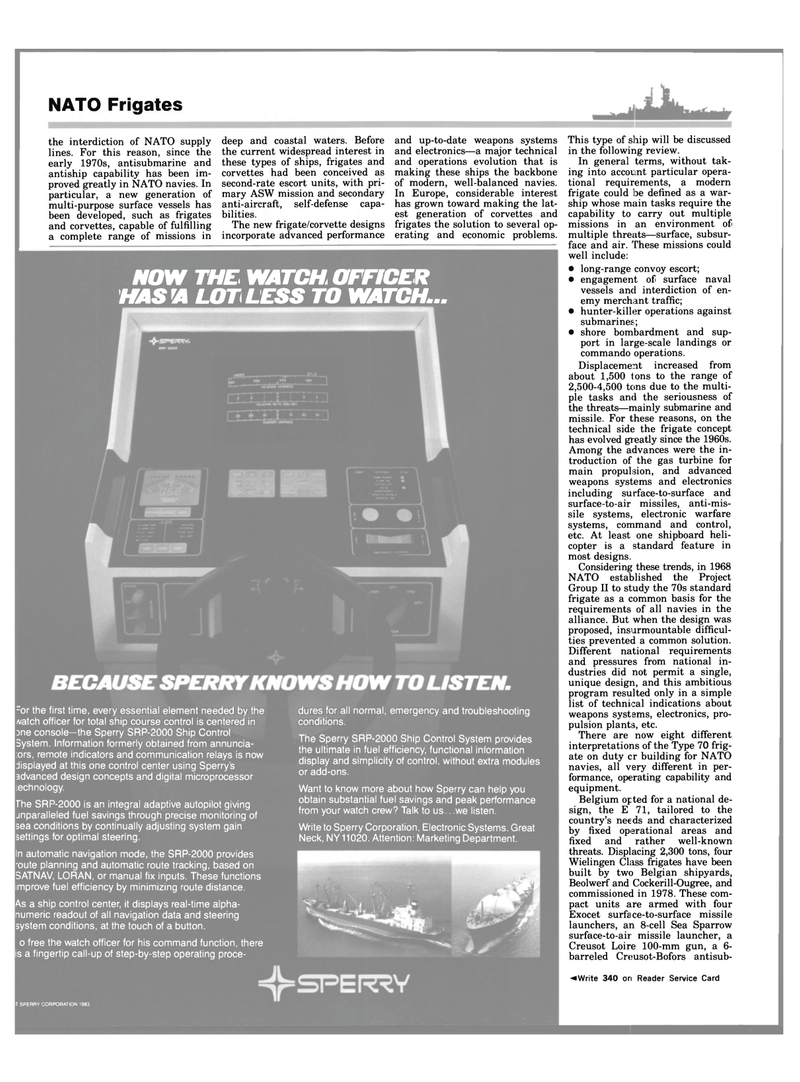
Page 32: of Maritime Reporter Magazine (October 15, 1983)
Read this page in Pdf, Flash or Html5 edition of October 15, 1983 Maritime Reporter Magazine
NATO Frigates
NOW THE WATCH OFFICER HAS A LOT LESS TO WATCH... the interdiction of NATO supply lines. For this reason, since the early 1970s, antisubmarine and antiship capability has been im- proved greatly in NATO navies. In particular, a new generation of multi-purpose surface vessels has been developed, such as frigates and corvettes, capable of fulfilling a complete range of missions in deep and coastal waters. Before the current widespread interest in these types of ships, frigates and corvettes had been conceived as second-rate escort units, with pri- mary ASW mission and secondary anti-aircraft, self-defense capa- bilities.
The new frigate/corvette designs incorporate advanced performance and up-to-date weapons systems and electronics—a major technical and operations evolution that is making these ships the backbone of modern, well-balanced navies.
In Europe, considerable interest has grown toward making the lat- est generation of corvettes and frigates the solution to several op- erating and economic problems.
This type of ship will be discussed in the following review.
In general terms, without tak- ing into account particular opera- tional requirements, a modern frigate could be defined as a war- ship whose main tasks require the capability to carry out multiple missions in an environment of multiple threats—surface, subsur- face and air. These missions could well include: • long-range convoy escort; • engagement of surface naval vessels and interdiction of en- emy merchant traffic; • hunter-killer operations against submarines; • shore bombardment and sup- port in large-scale landings or commando operations.
Displacement increased from about 1,500 tons to the range of 2,500-4,500 tons due to the multi- ple tasks and the seriousness of the threats—mainly submarine and missile. For these reasons, on the technical side the frigate concept has evolved gr eatly since the 1960s.
Among the advances were the in- troduction of the gas turbine for main propulsion, and advanced weapons systems and electronics including surface-to-surface and surface-to-air missiles, anti-mis- sile systems, electronic warfare systems, command and control, etc. At least one shipboard heli- copter is a standard feature in most designs.
Considering these trends, in 1968
NATO established the Project
Group II to study the 70s standard frigate as a common basis for the requirements of all navies in the alliance. But when the design was proposed, insurmountable difficul- ties prevented a common solution.
Different national requirements and pressures from national in- dustries did not permit a single, unique design, and this ambitious program resulted only in a simple list of technical indications about weapons systems, electronics, pro- pulsion plants, etc.
There are now eight different interpretations of the Type 70 frig- ate on duty cr building for NATO navies, all very different in per- formance, operating capability and equipment.
Belgium opted for a national de- sign, the E 71, tailored to the country's needs and characterized by fixed operational areas and fixed and rather well-known threats. Displacing 2,300 tons, four
Wielingen Class frigates have been built by two Belgian shipyards,
Beolwerf and Cockerill-Ougree, and commissioned in 1978. These com- pact units are armed with four
Exocet surface-to-surface missile launchers, an 8-cell Sea Sparrow surface-to-air missile launcher, a
Creusot Loire 100-mm gun, a 6- barreled Creusot-Bofors antisub- -«Write 340 ori Reader Service Card zor the first time, every essential element needed by the /vatch officer for total ship course control is centered in
Dne console—the Sperry SRP-2000 Ship Control
System. Information formerly obtained from annuncia- ors, remote indicators and communication relays is now displayed at this one control center using Sperry's advanced design concepts and digital microprocessor technology.
The SRP-2000 is an integral adaptive autopilot giving jnparalleled fuel savings through precise monitoring of sea conditions by continually adjusting system gain settings for optimal steering.
In automatic navigation mode, the SRP-2000 provides route planning and automatic route tracking, based on
SATNAV, LORAN, or manual fix inputs. These functions improve fuel efficiency by minimizing route distance.
As a ship control center, it displays real-time alpha- numeric readout of all navigation data and steering system conditions, at the touch of a button.
To free the watch officer for his command function, there is a fingertip call-up of step-by-step operating proce- dures for all normal, emergency and troubleshooting conditions.
The Sperry SRP-2000 Ship Control System provides the ultimate in fuel efficiency, functional information display and simplicity of control, without extra modules or add-ons.
Want to know more about how Sperry can help you obtain substantial fuel savings and peak performance from your watch crew? Talk to us.. we listen.
Write to Sperry Corporation, Electronic Systems. Great
Neck, NY 11020. Attention: Marketing Department. i SPERRY CORPORATION 1983

 31
31

 33
33
